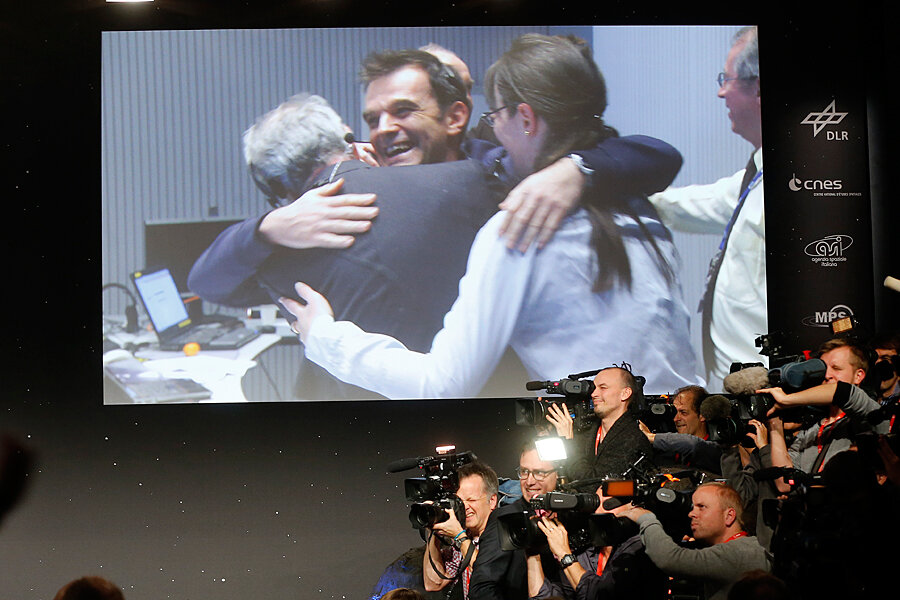Rosetta's Philae completes historic landing, but fails to anchor to comet
Loading...
[Update: The European Space Agency announced that Philae encountered problems securing its harpoon anchor.]
“We are on the comet.”
With those words, the landing manager for the European Space Agency's Philae comet lander, Stephan Ulamec, officially confirmed a historic space-exploration first: the soft-landing of an experiment-laden package from Earth on the nucleus of a comet.
Telemetry from the Philae confirming the landing arrived at 11:03 A.M. Eastern Standard Time Tuesday, after traveling 317 million miles – 28 minutes away as the radio signal hurtles.
Using its mother ship – ESA's Rosetta comet orbiter – as a relay station, the lander Philae phoned home to say that it had arrived. But as controllers analyzed the telemetry coming back from the lander, it became clear that the harpoon that was to firmly anchor the craft to the nucleus had failed to deploy.
At a post-launch briefing, Mr. Ulamec, Philae lander manager, acknowledged the lander may have lifted off of the surface, perhaps even landing a second time.
“Hopefully we are sitting on the surface,” he said.
The news has tempered some of the enthusiasm earlier in the day when it seemed as though the craft's arrival was fully successful.
The initial news of touchdown was greeted with the universal language of mission-control rooms everywhere when the difficult is accomplished: hugs, applause, and high-fives.
For the mission and ESA, the larger mission remains a significant demonstration how far the agency has come during the past 39 years in its ability to plan and execute challenging solar-system exploration missions.
Rosetta's trip to comet 67P/Churyumov-Gerasimenko itself made history as the first mission to send an orbiter to a comet, rather than a planet. The mission launched in 2004, and arrived at the comet in August after being awakened from 31 months of hibernation.
Even without an anchor, Philae's controlled landing marks an improvement over ESA's first attempt at placing a lander on another solar-system object. Its first attempt with the Beagle 2 lander, part of its 2003 Mars Express mission, failed to return any signal of its condition after it was to have landed, leading ESA to declare it lost.
Philae's prospects for already had taken one hit during the countdown to its release from Rosetta. Mission controllers found that a thruster on top of the craft wasn't working. The thruster was to have helped keep the craft from bouncing off the nucleus of the gravitationally weak comet when it landed. And it was to have kept the lander from leaving the nucleus when the lander's harpoon was shot into the surface to serve as an anchor.
Now come efforts to try to determine the lander's status and salvage as much science as possible. Mission planners say the craft has a pre-programmed to-do list that cover its first 60 hours on comet 67P/Churyumov-Gerasimenko's nucleus. Once that ends, the research team associated with the lander will have an opportunity to conduct whatever follow-up measurements they can fit in before the lander's battery needs to be recharged.
Assuming conditions on the surface remain favorable enough to allow the solar panels on the lander to keep the battery topped off, scientists could continue to gather measurements for as long as three months.
The nine instruments aboard the craft are designed for a range of experiments: From measure the chemical composition of the cometary core's soil, ices, and of the gases it gives off as it warms to studies of the object's soil mechanics and interior structure, the lander will give scientists unprecedented insights into these snowy dirt balls, remnants from the dawn of the solar system.
The lander's drilling system, for instance, will give researchers a detailed look at the composition of relatively pristine material that has not been affected by repeated round trips that bring as close as 1.2 astronomical units (A.U.) from the sun, or 1.2 times the distance between Earth and the sun.
In the process, comet 67P/Churyumov-Gerasimenko could yield clues about the composition of objects in the Kuiper Belt, a region that extends from Neptune's orbit out to about 50 A.U. Comet 67P/Churyumov-Gerasimenko belongs to a family of comets known as Jupiter comets. These are thought to have originated in the Kuiper Belt and now trace orbits around the sun that have been shaped through Jupiter's gravitational influence.
Philae also was to play a key role in a radio experiment designed to uncover the interior structure of the comet, whose profile resembles a child's rubber ducky. Rosetta's orbit was tweaked so that it passed over Philae's landing site for relaying data from the lander. As Rosetta moves out of sight of the lander, it was to have sent radio signals through the comet to Philae, which would have vollyed them right back at the orbiter. The experiment was expected to result in the first CT-like scan of a comet nucleus.
If all goes well, more than a year of science lies ahead of Rosetta itself. But the craft will start to run out of fuel late in the summer of 2016. ESA planners already are considering how to end the mission. One option, mission officials say, is to have Rosetta join Philae.
“We may park Rosetta on the surface at the end,” said one mission official.






